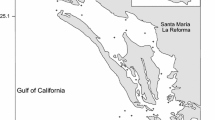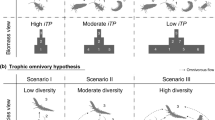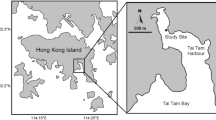Abstract
We present a protocol and calculation methods for the determination of zooplankton ingestion and assimilation rates with stable isotope tracers. These methods have been developed from experiments with the rotifer Brachionus calyciflorus that had been fed 13C-labelled Scenedesmus obliquus. Stable isotope tracers offer the same advantages as radioisotopes. These include the possibility for direct and accurate quantification of ingestion and assimilation rates, short sample analysis times and low animal densities requirements. However, the use of stable isotope tracers requires relatively long sample preparation times and specialist equipment and is, thus, relatively costly for most laboratories. The application of stable isotope tracers in zooplankton feeding studies offers several advantages in comparison with radioisotopes. Firstly, they do not emit harmful radiation and can therefore be applied safely both in the laboratory and in the field. Secondly, the samples can be dried for safe storage and easy transportation. Thirdly, no aggressive chemicals are required for sample analysis.
Similar content being viewed by others
References
M. A. Baars S. S. Oosterhuis (1985) ArticleTitleZooplankton grazing in natural water with high concentration of 14C bicarbonate: variable controls and gut passage time Hydrobiological Bulletin 19 71–80
S. Bearhop D. R. Thompson S. Waldron I. S. Russell G. Alexander R. W. Furness (1999) ArticleTitleStable isotopes indicate the extent of freshwater feeding by cormorants Phalacrocorax carbo shot at inland fisheries in England Journal of Applied Ecology 36 75–84 Occurrence Handle10.1046/j.1365-2664.1999.00378.x
H. K. Berthold D. L. Hachey P. J. Reeds O. P Thomas S. P. D. Hoeksema Klein (1991) ArticleTitleUniformly 13C-labeled algal protein used to determine amino acid essentiality in vivo Proceedings of the National Academy of Sciences (USA) 88 8091–8095
H. T. S. Boschker J. Middelburg (2002) ArticleTitleMinireview: Stable isotopes and biomarkers in microbial ecology FEMS Microbiology Ecology 40 85–95 Occurrence Handle10.1016/S0168-6496(02)00194-0
M. T. Brett (1993) ArticleTitleComment on “Possibility of N or P limitation for planktonic cladocerans: and experimental test” (Urabe and Watanabe) and “Nutrient limitation of zooplankton production.” (Hessen) Limnology and Oceanography 38 1333–1337
K. R. Carman B. Fry (2002) ArticleTitleSmall-sample methods for delta C-13 and delta N-15 analysis of the diets of marsh meiofaunal species using natural-abundance and tracer-addition isotope techniques Marine Ecology Progress Series 240 85–92
M. J. DeNiro S. Epstein (1978) ArticleTitleInfluence of the diet on the distribution of carbon isotopes in animals Geochimica et Cosmochimica Acta 42 495–506 Occurrence Handle10.1016/0016-7037(78)90199-0
M. Gophen B. Z. Cavari T. Berman (1973) ArticleTitleZooplankton feeding on differentially labelled algae and bacteria Nature 247 393–394 Occurrence Handle10.1038/247393a0
Guillard (1975) Cultures of phytoplankton for feeding of marine invertebrates Smith (Eds) Culture of Marine Invertebrate Animals Plenum New York 29–60
R. D. Gulati (1985) ArticleTitleZooplankton grazing methods using radioactive tracers: technical problems Hydrobiological Bulletin 19 61–69
A. Hammer C. Grüttner R. Schumann (2001) ArticleTitleNew biocompatible tracer particles: use for estimation of microzooplankton grazing, digestion, and growth rates Aquatic Microbial Ecology 24 153–161
T. Hasegawa I. Koike H. Mukai (2001) ArticleTitleFate of food nitrogen in marine copepods Marine Ecology Progress Series 210 167–174
D. O. Hessen (1992) ArticleTitleNutrient element limitation of zooplankton production The American Naturalist 140 799–814 Occurrence Handle10.1086/285441
D. O. Hessen (1993) ArticleTitleThe role of mineral nutrients for zooplankton nutrition: Reply to the comment by Brett Limnology and Oceanography 38 1340–1343
A. Hino S. Aoki M. Ushiro (1997) ArticleTitleNitrogen-flow in the rotifer Brachionus rotundiformis and its significance in mass cultures Hydrobiologia 358 77–82 Occurrence Handle10.1023/A:1003128305910
W. Lampert (1974) ArticleTitleA method for determining food selection by zooplankton Limnology and Oceanography 19 995–998
W. Lampert (1977a) ArticleTitleStudies on the carbon balance of Daphnia pulex as related to environmental conditions. I. Methodological problems of the use of 14C for the measurement of carbon assimilation Archiv für Hydrobiologie 48: IssueIDSuppl. 287–309
W. Lampert (1977b) ArticleTitleStudies on the carbon balance of Daphnia pulex as related to environmental conditions II. The dependence of carbon assimilation on animal size, temperature, food concentration and diet species Archiv für Hydrobiologie 48 310–335
W. Lampert W. Gabriel (1984) ArticleTitleTracer kinetics in Daphnia: an improved two-compartment model and experimental test Archiv für Hydrobiologie 100 1–20
W. Lampert J. Grey (2003) ArticleTitleExploitation of a deep-water algal maximum by Daphnia: a stable-isotope tracer study Hydrobiologia 500 95–101 Occurrence Handle10.1023/A:1024644815548
W. Lampert B. E. Taylor (1985) ArticleTitleZooplankton grazing in a eutrophic lake: implications of diel vertical migration Ecology 66 68–82
N. Lindemann W. Kleinow (2000) ArticleTitleA study of rotifer feeding and digestive processes using erythrocytes as microparticulate markers Hydrobiologia 435 27–41 Occurrence Handle10.1023/A:1004029304590
M. Lürling A. M. Verschoor (2003) ArticleTitleF0-spectra of chlorophyll fluorescence for the determination of zooplankton grazing Hydrobiologia 491 145–157 Occurrence Handle10.1023/A:1024436508387
D. C. Müller-Navarra M. T. Brett A. M. Liston (2000) ArticleTitleA highly unsaturated fatty acid predicts carbon transfer between primary producers and consumers Nature 403 74–77 Occurrence Handle10.1038/47469 Occurrence Handle10638754
D. C. Müller-Navarra M. T. Brett S. Park S. Chandra A. P. Ballantyne E. Zorita C. R. Goldman (2004) ArticleTitleUnsaturated fatty acid content in seston and tropho-dynamic coupling in lakes Nature 427 69–72 Occurrence Handle10.1038/nature02210 Occurrence Handle14702086
D. L. Penry B. W. Frost (1990) ArticleTitleRe-evaluation of the gut-fullness (gut fluorescence) method for inferring ingestion rates of suspension-feeding copepods Limnology and Oceanography 35 1207–1214
R. H Peters (1984) Methods for the study of feeding, grazing and assimilation by zooplankton J. A. Downing F. H. Rigler (Eds) A manual for the assessment of secondary production in fresh waters. IBP Handbook 17 EditionNumber2 Blackwell Oxford 336–412
B. J. Peterson B. Fry (1987) ArticleTitleStable isotopes in ecosystem studies Annual Reviews of Ecology and Systematics 18 293–320 Occurrence Handle10.1146/annurev.es.18.110187.001453
A. Pilati W. A. Wurtsbaugh (2003) ArticleTitleImportance of zooplankton for the persistence of a deep chlorophyll layer: A Limnocorral experiment Limnology and Oceanography 48 249–260
F. H. Rigler (1971) Methods for the measurement of assimilation of food by zooplankton W. T. Edmondson (Eds) A manual on methods for the assessment of secondary production. IBP Handbook No. 17 Blackwell Scientific Publications Oxford/Edinburgh 264–269
K. O. Rothhaupt (1990) ArticleTitleChanges of the functional responses of the rotifers Brachionus rubens and Brachionus calyciflorus with particle sizes Limnology and Oceanography 35 24–32
P. L. Starkweather J. J. Gilbert (1977a) ArticleTitleRadiotracer determination of feeding in Brachionus calyciflorus: The importance of gut passage times Archiv für Hydrobiologie, Ergebnisse der Limnologie 8 261–263
P. L. Starkweather J. J. Gilbert (1977b) ArticleTitleFeeding in the rotifer Brachionus calyciflorus 2. Effect of food density on feeding rates using Euglena gracilis and Rhodotorula glutinis Oecologia 28 133–139 Occurrence Handle10.1007/BF00345248
J. Urabe Y. Watanabe (1992) ArticleTitlePossibility of N or P limitation for planktonic cladocerans: an experimental test Limnology and Oceanography 37 244–251
J. Urabe Y. Watanabe (1993) ArticleTitleImplications of sestonic elemental ratio in zooplankton ecology: Reply to the comment by Brett Limnology and Oceanography 38 1337–1340
J. Urabe J. Clasen R.W. Sterner (1997) ArticleTitlePhosphorus limitation of Daphnia growth: Is it real? Limnology and Oceanography 42 1436–1443
M. J. Van der Zanden B. J. Shuter N. Lester J. B. Rasmussen (1999) ArticleTitlePatterns of food chain lengths in lakes: A stable isotope study The American Naturalist 154 406–416 Occurrence Handle10.1086/303250 Occurrence Handle10523487
E. Von Elert ParticleVon (2002) ArticleTitleDetermination of limiting polyunsaturated fatty acids in Daphnia galeata using a new method to enrich algae with single fatty acids Limnology and Oceanography 47 1764–1773
Author information
Authors and Affiliations
Corresponding author
Rights and permissions
About this article
Cite this article
Verschoor, A.M., Boonstra, H. & Meijer, T. Application of Stable Isotope Tracers to Studies of Zooplankton Feeding, using the Rotifer Brachionus calyciflorus as an Example. Hydrobiologia 546, 535–549 (2005). https://doi.org/10.1007/s10750-005-4296-x
Issue Date:
DOI: https://doi.org/10.1007/s10750-005-4296-x




